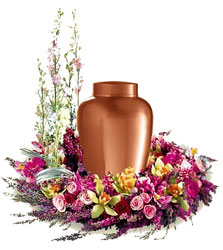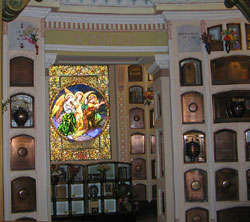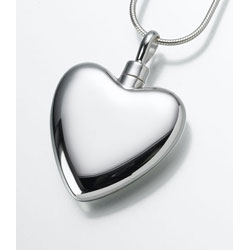Cremation Urn Memorial Ideas


Final placement of the cremation urn or keepsake urn refers to where and how the urn is ultimately located; generally on a permanent basis, but also temporarily until an appropriate, meaningful and final permanent placement is determined. Final placement may be accomplished by interment (burial) niche placement, home, scattering or spreading the ashes.
URN BURIAL:
Earth burial of a cremation urn can take place at a cemetery, or possibly on private property depending on the laws in your area. In many locations, the cemetery will require the cremation urn to be placed in an outer burial container or burial vault.
URN VAULTS
Urn vaults are designed to contain the burial urn and protect the integrity of the burial site by supporting the weight of the earth around and above the burial site. Urn vaults can be constructed of steel, bronze, concrete, and many are lightweight polymer materials. The urn vault should protect the cremation urn by resisting outside elements such as ground water that naturally occur at a burial site. Some designs accomplish this using a the captured air pressure system of an inverted dome cover over a base. Others close with metal clip-locks or an industrial strength adhesive system, or a combination of closures.
NICHE PLACEMENT
Niche Placement can occur at several different types of locations, however, they all have one thing in common; the urn is placed in a small space above ground that is secured with a cover. Niches are designed in many different dimensions in order to accommodate a variety of urn sizes. Niche placement is a popular option at veteran cemeteries and an option in some areas at churches and universities.
COLUMBARIUM
A columbarium is a specially designed unit containing multiple niches arranged in vertical columns and horizontal rows. Most columbaria are found in cemeteries, mausoleums, crematories, or churches. Each columbarium may feature both glass front and solid front niches.

GLASS FRONT NICHES
A glass front niche is designed so that the funeral urn remains visible after niche placement; the cover securing the niche pace is made of durable transparent glass.
SOLID FRONT NICHES
Solid front niches are designed so the urn is not visible after niche placement; the niche cover is usually made of stone or bronze.
CEMETERY LAWN NICHES
Cemetery lawn niches are specially designed units that are very similar in appearance to upright monuments. Like monuments, lawn niches are made of stone such as granite or marble. The main section of the unit contains niche spaces for the placement of cremation urns or keepsakes. New designs include stone benches that are attractive and urn storage is usually located in the legs or base of the bench.
KEEPING THE URN IN THE HOME
Simply put- families are choosing to keep the urn in the home of family members, friends, or significant others. Home placement may either be permanent or temporary until such time another method of final placement may be arranged. If this arrangement is chosen it's best to make plans for the transfer or placement of the urn in the event of the death of the conservator.
SCATTERING THE ASHES
Scattering the ashes is another method for the final placement of the remains. Families should consider that this method is an irreversible act and is final once completed. Some families choose to retain a small portion of the ashes to store in a keepsake urn and have a tangible and permanent place for memorialization and future generations.

SCATTERING GARDEN
A scattering garden is a specially designed area in a cemetery or other outdoor area. It is generally landscaped to resemble a park-like setting and sometimes contains water features and rock formations. Ashes are scattered or spread in the garden and sometimes commingled with other individuals.
AN OSSUARY
An Ossuary is an underground vault area in a cemetery that has an opening to the surface into which the cremations are placed and commingled with other individuals.
LEASED STORAGE
Sometimes the funeral homes and crematories will provide space for either long-term or temporary storage of an urn containing ashes. Families pay for this service based on the location and the length of storage time that is desired. Generally such storage is provided in a communal area with shelving units where the urns with the ashes of others are also kept.

